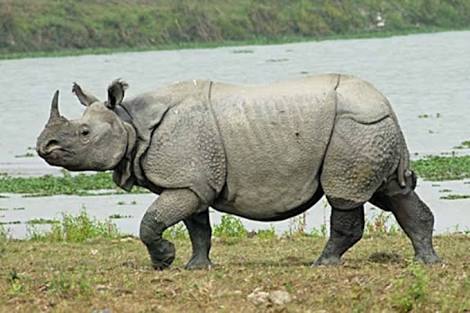Badak jawa cula satu
.jpeg)
Javan rhinoceros, or small-horned rhinoceros (Rhinoceros sondaicus) are members of the Rhinocerotidae family and one of the five remaining rhinos. This rhino enters the same genus as the Indian rhinoceros and has a mosaic skin resembling a steel armor. The rhino has a length of 3.1 to 3.2 m and a height of 1.4 to 1.7 m. The rhino is smaller than the Indian rhinoceros and is closer in size to the black rhino. The size of the horn is usually less than 20 cm, smaller than that of other rhino species.
.jpeg)
This rhinoceros was once one of Asia's most widespread rhinos. Although called "Javan rhino", this animal is not limited to live on the island of Java alone, but throughout the archipelago, throughout Southeast Asia and in India and China. This species is now very critical, with few populations found in the wild, and none in the zoo. The rhino is probably the rarest mammal on earth. [4] Population 40-50 rhinos live in Ujung Kulon National Park on the island of Java, Indonesia. The population of Javan rhinoceros in the outdoors is located in Cat Tien National Park, Vietnam with an estimated population of no more than eight in 2007. The decline in Javan rhino population is due to hunting for its horn, which is very valuable in traditional Chinese medicine, at a price of $ 30,000 kilograms on the black market. [4] The decline in rhino population is also caused by habitat loss, which is mainly caused by war, as the Vietnam war in Southeast Asia also caused a decrease in the Javan rhino population and hindered the recovery. [5] The remaining places are only in two protected areas, but the Javan Rhinos are still at risk of being hunted, sensitive to disease and shrinking genetic diversity causing it to be disturbed in the breed. WWF Indonesia seeks to develop both for the Javan rhino because if there is an attack of disease or natural disaster such as tsunami, Krakatau volcano eruption and earthquake, Javan rhino population will be directly extinct. [6] In addition, because of the invasions of langkap (arenga) and competition with bulls for space and resources, the population is increasingly urged. [6] The identified area is safe and relatively close to Halimun National Park in Mount Salak, West Java, which once served as a Javan rhino habitat.
.jpeg)
Javan rhino can live for 30-45 years in the wild. The rhinos live in lowland rain forest, wet meadows and large flooded land areas. Javan rhinocerms are mostly calm, except for the time to know and raise children, although a group can occasionally gather near the puddles and where they get minerals. Adult rhinos have no predators as enemies. Javan Rhinos usually avoid humans, but will attack humans if they feel disturbed. Natural researchers and protectors rarely examine the animals directly because of their scarcity and the danger of harassing an endangered species. Researchers used cameras and dirt samples to measure their health and behavior. The Javan Rhino is less studied than other rhino species.
.jpeg)
really cruel man
Upvote and follow me
Hi! I am a robot. I just upvoted you! I found similar content that readers might be interested in:
http://www.iniono.ga/2017/08/javanese-rhino-endangered-animal-from.html